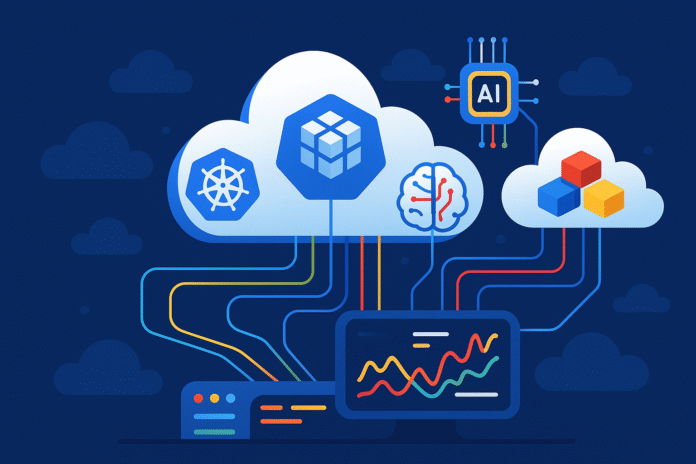Kubernetes has been the foundation of modern infrastructure for a decade, quietly running the cloud-native applications all around the world. This year marks 10 years of Google Kubernetes Engine (GKE), and Google isn’t looking back. The company’s new wave of updates, unveiled at KubeCon 2025 in Atlanta, shows how Kubernetes is evolving to handle the demands of large-scale AI, inference, and “agentic” systems.
For developers, this evolution means fewer trade-offs between speed, scale, and simplicity. For enterprises, it marks a shift from Kubernetes as a container orchestrator to Kubernetes as an AI operations platform built for the “Gigawatt AI Era,” where infrastructure runs massive distributed models across hybrid and multicloud environments.
Google’s key message is clear: AI workloads need orchestration as smart as the models themselves.
From Chaos to Control: The New AI-Native Kubernetes
Google’s updates are designed to simplify life for developers running distributed compute, AI training, and inference workloads. The company is tackling a long-standing pain point: managing fragmented frameworks and infrastructure that slow experimentation and scale.
In collaboration with the open-source community, Google has expanded native support for frameworks like Slurm and Ray, integrating them directly into GKE through managed schedulers such as RayTurbo and Cluster Director for Slurm. These integrations reduce friction, speed up distributed training, and increase resource utilization. RayTurbo alone delivers 4.5x faster processing while using 50% fewer nodes.
Beyond performance, Google is investing deeply in Kubernetes for AI inference, the stage where models meet production. New open-source components, such as the Gateway API Inference Extension and Dynamic Resource Allocation, make Kubernetes smarter at routing requests, balancing loads, and dynamically assigning GPUs, TPUs, and accelerators to workloads.
The result? Teams can run LLMs and complex AI models on Kubernetes with better reliability, faster response times, and lower cost, a critical improvement for those scaling Generative AI into real-world applications.
A Platform for the Gigawatt AI Era
As model sizes and cluster demands explode, Google is pushing Kubernetes to new limits. The company has now validated 65,000-node clusters, introducing multi-cluster orchestration and job-sharding capabilities through the MultiKueue operator and enhanced support for open-source tooling like JobSet and etcd.
For developers, this means:
- More consistent scaling across jobs and clusters.
- Dynamic capacity reallocation, which moves resources in real time based on workload needs.
- Single-cluster performance that can handle workloads once thought impossible in Kubernetes.
These updates help Kubernetes evolve from managing web apps to orchestrating entire AI data centers. In Google’s own words, it’s Kubernetes built for “frontier-scale computing.”
Autopilot Everywhere: Smarter, Faster, Simpler
Google is also making Kubernetes easier to operate. With the new Container-Optimized Compute Platform, GKE’s Autopilot mode now delivers near real-time autoscaling, reducing node provisioning time from minutes to seconds.
In practical terms, developers no longer have to over-provision clusters just in case. The platform scales up or down automatically as workloads fluctuate, cutting costs while maintaining steady performance. GKE Autopilot now supports both Standard and Autopilot clusters on a per-workload basis, providing development teams with full flexibility without added complexity.
It’s Kubernetes for the next generation of developers: fast, cost-aware, and maintenance-free.
Inference at Scale: From Speed to Efficiency
Serving large language models isn’t just about compute; it’s about managing stateful, resource-hungry workloads. To solve this, Google announced the general availability of GKE Inference Gateway, a Kubernetes-native solution for AI serving.
Two capabilities stand out:
- Context-aware routing, which directs repeat requests (like chat conversations) to accelerators that already have cached context, reducing latency.
- Disaggregated serving, which splits “prefill” and “decode” stages of inference onto different hardware pools optimized for each task.
Together, these optimizations drive up to 96% lower Time-to-First-Token latency and 25% lower token costs compared to other managed services.
For practitioners, this means faster, cheaper, and more predictable performance for production AI systems without rebuilding infrastructure.
Why It Matters: From Orchestration to Intelligence
Kubernetes has always been about consistency and control. What Google is doing now is turning that control into intelligence.
By deeply integrating AI frameworks, open-source schedulers, and smart resource management into GKE, Google is redefining what it means to run workloads at scale. The platform is becoming not just a scheduler, but a decision engine, one that understands context, learns patterns, and optimizes infrastructure in real time.
This matters because AI development no longer happens in silos. Training, inference, and monitoring are all part of one continuous loop. GKE’s evolution ensures that loop stays fast, efficient, and reliable.
The Bottom Line: Kubernetes for the AI Builders
Google’s KubeCon 2025 message isn’t about nostalgia; it’s about evolution. Ten years after GKE’s debut, Kubernetes is stepping into its next role as the core fabric of AI infrastructure.
For developers, it means faster scaling, better tooling, and less manual work. For AI teams, it brings consistent, reliable orchestration for models that span clusters, clouds, and continents. For buyers, it delivers cost savings and performance predictability in the face of runaway AI workloads.
The future Google is building toward is simple: Kubernetes as the foundation for intelligent, autonomous cloud operations. And with these new capabilities, that future looks a lot closer.


